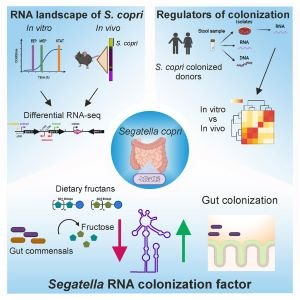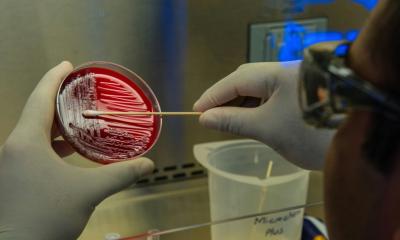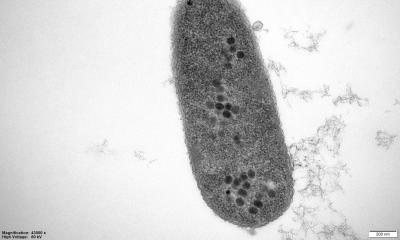
© Yan - stock.adobe.com
News • Microbiome research
Intensive research of intestinal microbiome: The vital role of small RNA in colonization
The intestinal microbiome is currently the subject of intensive research, as it is of great importance for human health. Intestinal bacteria play an essential role in the defense against dangerous pathogens, which is one of the reasons why the majority of them are among the good guys. On the other hand, some of our lodgers are more prevalent in specific diseases - for whatever reason. This also applies to the widespread but little-researched bacterium Segatella copri. The research group led by Prof Till Strowig at the Helmholtz Centre for Infection Research (HZI) wanted to determine what makes this bacterium tick. How does it adapt to its environment? And what signals does it react to?
The intestinal microbiome is a highly complex ecosystem with thousands of different types of bacteria. Live and let live, that is the motto. Harmonious coexistence is based on the fact that intestinal bacteria occupy different niches and communicate with each other.

When does Segatella gain the upper hand
The composition of the gut microbiome is not always the same. There are significant differences between different regions of the world; in the western, highly industrialized world, for example, different bacteria predominate than in developing countries. On the other hand, the gut microbiome varies from person to person in terms of the bacterial species represented and their colonization density. Despite these differences, there are basic patterns of intestinal colonization in which a particular key bacterium dominates. Segatella copri is the most prominent germ in one of these three so-called enterotypes. This intestinal bacterium is widespread in developing and emerging countries.
Despite its worldwide distribution, little research has been done on Segatella copri to date. What is known is that the bacterium specializes in the breakdown of dietary fiber. However, what role does it play concerning human health needs to be clarified: Is it beneficial, or, on the contrary, does it have adverse effects? Despite the wealth of data on the microbiome, studies to date have not provided an answer to this question.
Clarifying the health significance of Segatella copri is one of the goals of the research work of Prof Till Strowig, head of the "Microbial Immune Regulation" department at the HZI. Cultivating Segatella in the laboratory is difficult, but Strowig's team has succeeded. "We wanted to find out under which conditions increased colonization with Segatella copri occurs and which processes occur in the cells. To do this, we need insights into how these bacteria work," says Till Strowig.
According to our research results, the breakdown of large amounts of fructans appears to influence communication between different intestinal bacteria
Till Strowig
Small snippet with a big impact
The program for all life processes is encoded in the genes, and this is no different in bacteria than in humans. When Segatella copri multiplies and spreads, complex metabolic processes are set in motion, to do this, the relevant genes have to be transcribed. For this transcription, the genetic information is transcribed from DNA (deoxyribonucleic acid) to RNA (ribonucleic acid).
We can determine which genes are currently active by examining the so-called transcriptome. This is the entirety of all RNA molecules in a cell at any given time. "While studying the transcriptome of Segatella copri, we came across a tiny snippet of RNA that plays an essential role in the reproduction and spread of the bacterium," reports first author Dr Youssef El-Mouali. The small piece of RNA - small RNA, to use the technical term - is significantly involved when Segatella copri breaks new ground. The researchers showed this in mice with a defined gut microbiome. The fact that "small RNAs" act as essential control elements in regulating cellular processes is also known from other living organisms, including humans.
Intestinal bacteria communicate with each other.
The researchers named the RNA snippet discovered in Segatella copri SrcF (Segatella RNA colonization factor) and took a closer look at it. They wanted to clarify the question: When is SrcF expressed in the cells? The assumption is that the multiplication of the bacterium is dependent on the food supply. If there is a high supply of dietary fiber, from which S. copri obtains energy, the bacteria will spread and conquer new habitats. The researchers were able to show that certain complex carbohydrates trigger the formation of SrcF. In contrast, a high concentration of fructans - polysaccharides consisting mainly of fruit sugar (fructose) - suppresses SrcF activity.
The researchers also discovered something else: The microbiome's composition influences whether Segatella copri activates the signaling pathway via SrcF. The many different bacterial species that live in peaceful coexistence in the gut compete for available resources and communicate with each other. This is the only way to explain the balanced state of the microbiome: The individual composition of the intestinal microbiome is surprisingly constant, and even after temporary turbulence, the old balance within this ecosystem is usually restored.
"According to our research results, the breakdown of large amounts of fructans appears to influence communication between different intestinal bacteria," says Till Strowig. "We will continue our research in this direction and hope that the better understanding of the gut microbiome that we want to contribute to will eventually be used specifically with a view to human health."
09.10.2024











